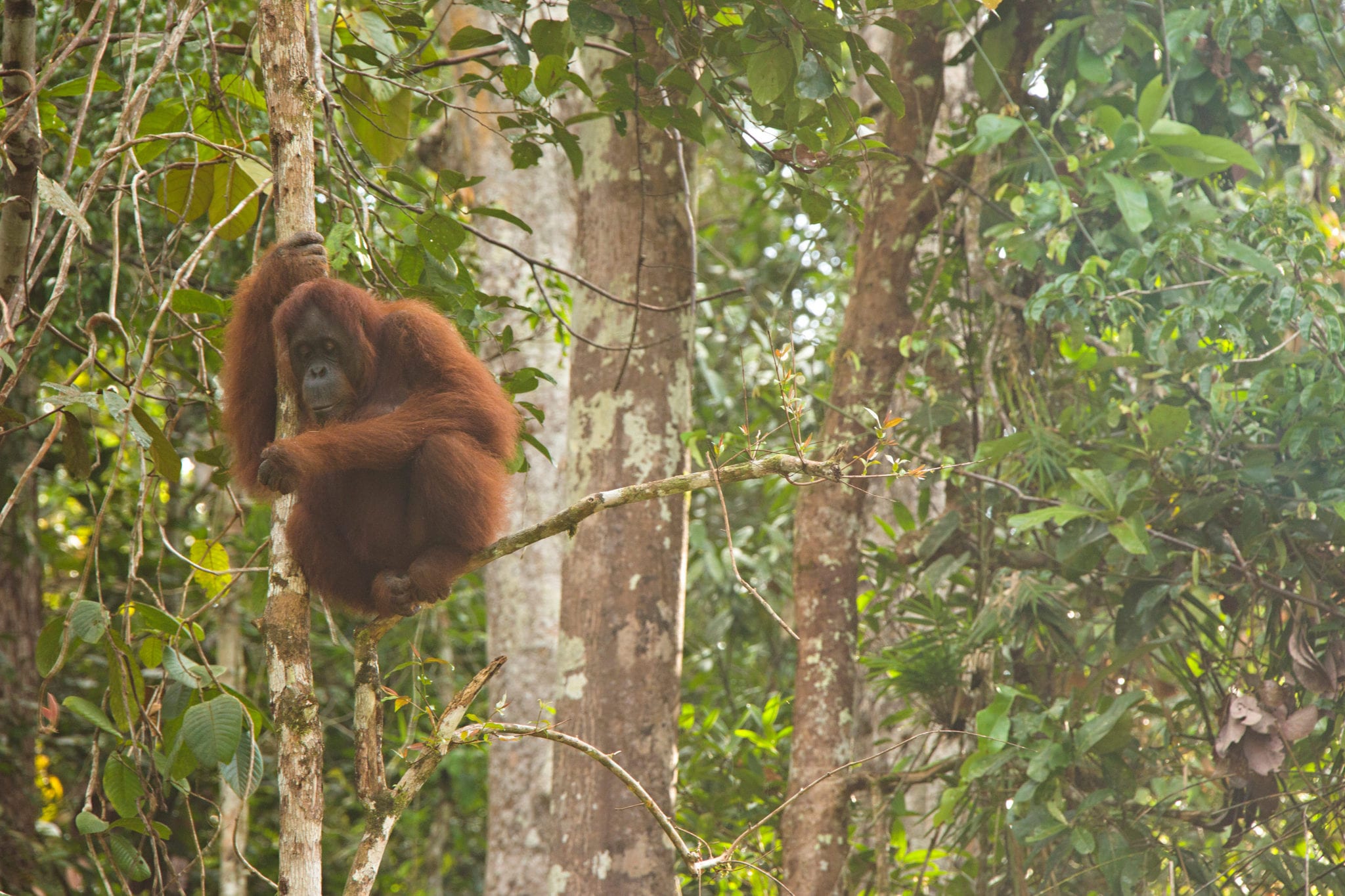
We arrived in Kuching very late in the afternoon on the 22nd, just in time to track down somewhere to stay and set out to find dinner. I was in the grips of a good little bout of sinus congestion and, when it became apparent that Kuching appeared to have shut down for the day (Seriously. Everything was shut.), we ended up back at Green Hill Corner food hall, an option that had been recommended by the eccentric-but-friendly manager at Tracks guesthouse. With only two choices – satay or something that appeared to be beef and noodles in broth, we went for what was easiest: both. The soup was exactly what I needed; sometimes, it’s hard to beat chicken (well, beef) noodle soup when you’re sick. Add a little calamansi juice and some chilli and now I’m an even happier happy camper, even if I am stuffed up. The beef and chicken satay were divine; I’ve got to work on my satay sauce recipe. On a good day, it would’ve been hard to get me out of there; on Friday, though, I was quite looking forward to my bed, especially because we were going to be up early in order to catch a 7am bus to the Semenggoh Orang-Utan Rehab Centre. Little did I know what was waiting for us back at the hostel..
Our friend, Kim, with whom we caught up in KK, had mentioned an American fellow by the name of Steve in one of her blog posts. Reading between the lines, I figured he was more than a little loud and, having had a quick glimpse at some FB photos, I remembered a white shirt with rolled up sleeves.Turns out, I’m a VERY good reader and I remember the important bits of photos. We’d heard a loud American voice at Threehouse, the first guesthouse we had stopped at (they were full) and were somewhat grateful when we realised we wouldn’t be staying with the loud talker. Turns out that Mr “No-Indoor-Voice” wasn’t staying there, either – he was joining us at Tracks.
I sent Kim a msg: “I think we found Steve. I’m guessing that there can’t really be that many loud Americans in white shirts in Borneo, right?”
“That’s him. Hilarious!” came her reply.
Two hours of loud talking later, and we didn’t think so.
Steve finally decided to call it a day, leaving us to enjoy the thumping club music drifting over from the club across the street. 2:30am and it’s chucking-out time. Apparently, Xtreme (or however they misspelled their name) still has fans; “Be With You” was the end-of-night song and was stuck in my head for days.
Needless to say, 6:30 came early, but we know that hosteling has its good nights and bad. We hauled ourselves out of bed, stocked up on toilet paper to serve as Kleenex, and got ourselves to the bus station and out to Semonggoh. At 8:15, we were walking through the centre’s main grounds, just as a mother orang and her baby – a few years old, judging by the size – decided to do the same. Barely a minute into our visit. Game on.
It’s fascinating to watch orangs, whether in the wild like along the Kinabatangan river or semi-wild like the ones at the centre. For animals of such a substantial size – about the height of a 10 yr old but with the bulk of a teenager, they move with such silence. The only reason you tend to know they are around is because the tree that they’ve just moved out of is rustling. As they walked past us, there wasn’t a sound. They were herded over to the feeding platform by one of the centre’s staff, who also kept a watchful eye on us to make sure our encounter wasn’t of the “too close” variety (orang attacks have horrific consequences, as evidenced by the photos at the arrival centre). Watching a mother and baby of this age is quite entertaining; the baby doesn’t follow so much as push Mama along. Not altogether very different from watching a human child who wants to get somewhere with a mother who keeps stopping to look at things of interest.
This pair settled in with some sweet potatoes, leaving us time to spot the arrival of Grandma, who was stealthily making her way across the canopy rope bridges towards another feeding platform. The agility and strength these animals possess is completely remarkable; opposite hand and foot holding a rope while the other two limbs hang loosely and their body fold backwards on itself. 30 feet above the ground.
Grandma didn’t seem as interested in food – which is provided as a means of supplementing the diet of animals struggling to find enough food, making the centre the orang equivalent of a soup kitchen – as in making sure that the other two didn’t get into trouble. She sat in a tree nearby, while Junior put on a little show for the 5 or 6 of us who had arrived early enough; there was some climbing on Mom, some stretching from branch to branch, followed by gentle swinging, feet held aloft as if to say “See what I can do??”
Within a few minutes, the tour groups started to arrive in earnest, meaning our group of half a dozen rapidly expanded to 60 or more. An announcement was made shortly thereafter: the centre was very excited to have a new mother and her baby at a feeding station that morning and, should visitors wish, they could walk down a trail to another feeding station to see them. We wished. And, given that most of the tour groups seemed to be comprised of loud Germans and/or Russians, we decided to leg it down the trail in order to enjoy a few moments of peace with the new family before the chattering groups arrived. When we got to the viewing area, the staff were standing inches away from Mom trying to get photos of the baby in order to determine the gender – the baby was THAT new to them. It turns out that he (it’s a boy!) was estimated to be no more than 2-3 months old; Mom hadn’t been seen at the centre for 3-4 months. So exciting! We spent about 20mins watching the pair as Mom climbed through the branches and snacked on coconut and sweet potato, all while keeping an eye on her visitors down below.
Back at the main grounds, we discovered that Mama and her child had moved – right into the thick of the visitors’ area. They had commandeered a section of the shaded seating area and were hanging out on the boards, Mama smashing her coconut on the ground and tucking into breakfast, while Kiddo wore the husk on his head in a real-life version of what always seemed staged on TV. At one stage, he took a bit of sweet potato and tucked it between his shoulder and head while he repositioned himself. Problem: he’s not very good at this trick yet, and the food rolled away. You could almost see the dismay in the body language: shoulders suddenly slumped, eyes darted up at us and back to Mama, fidgety feet while he tried to decide what to do. More than an arm’s reach out from where he stood, fingers firmly grasping Mama’s hair, and suddenly that potato is in no-man’s land. Watching his audience the whole time, he reeeeeached out, wriggling his fingers at the potato, begging it to leap into his hand. No go. Going to have to let go of Mama. Little step forward, reeeeeeeach out, get the potato. Success.
A little after ten, the centre’s staff thanked everyone for their visit. Read between the lines: time to go. The centre closes between the two daily feeding times, which I appreciate: it isn’t a zoo; the animals come and go at will, but if there are humans around all the time, the centre’s efforts may well go to waste as the orangs begin to get overly familiar with people. Plus, the longer people stick around, the greater the chance of some foolish tourist trying to entice an orang out of a tree, bringing on an attack. Hard to protect people from their own stupidity all day every day. :)
Back to the city, and back to the hunt for food!
Grateful for: getting places early




